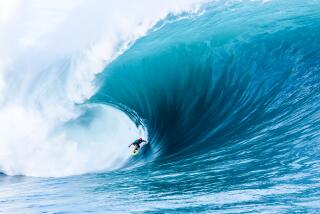He’s in This for the Long Haul
- Share via
It all began when someone stole his first surfboard.
Richard Harbour couldn’t afford to replace the birthday present from his parents and instead decided to build his own board.
It was 1959, and Harbour was 16 years old.
In the 40 years since he went into his parents’ garage with a piece of wood and a saw, Harbour has crafted more than 20,000 boards.
“When I arrived at the beach with that first board, I was laughed at pretty hard,” Harbour said. “I don’t like being laughed at for my craft, so I went back to the drawing board.”
After a while, Harbour’s custom-built designs were sought by fellow surfers, and today he owns Harbour Surfboards on Main Street in Seal Beach, the nation’s oldest surfboard shop at the same location.
Although his business partner, Robert Howson, 37, took over the front retail part of the store seven years ago, Harbour still builds all the surfboards in the shop’s dust-filled back rooms. “He is a craftsman, the guy who builds the Stradivarius,” Howson said.
Beneath the blue ceilings of his workshop that smells of cedar, the 56-year-old Seal Beach native designs and shapes the boards.
It takes seven days for Harbour to create a board from design to floating reality. He molds and shaves the polyurethane soul of the board, laying down a cedar or balsa spine before the board is painted and finally coated with fiberglass.
The profit margin on the long boards is narrow--around $100 per board--but money doesn’t motivate Harbour, his partner says.
“He doesn’t need to be Donald Trump,” Howson said. “His boards are coveted by the best surfers in the world. In the surfing world, he’s a legend.”
When Harbour began creating his own designs, the average board weighed between 25 and 30 pounds. Modern materials, such as polyurethane foam, have cut the boards’ weight by half. But the process of making the boards is the same as in the 1960s, Harbour said.
His boards from that period are collectibles, fetching thousands of dollars.
Every board made has a serial number, and each has been “autographed” with the logo he developed in high school when the teacher wasn’t looking.
The oldest board in Harbour’s possession is No. 18. That board, known as the “Garage Board,” decorates the shop’s ceiling.
Despite contemporary competition from surfboard factories and cheap mass production, Harbour isn’t worried.
“Some people are interested in art, and some are just interested in covering the blank spaces on the walls,” he said. “There’s a market for the assembly products and there’s a market for Rembrandts and Picassos.”
Louise Roug can be reached at (714) 966-5977.
More to Read
Sign up for The Wild
We’ll help you find the best places to hike, bike and run, as well as the perfect silent spots for meditation and yoga.
You may occasionally receive promotional content from the Los Angeles Times.






